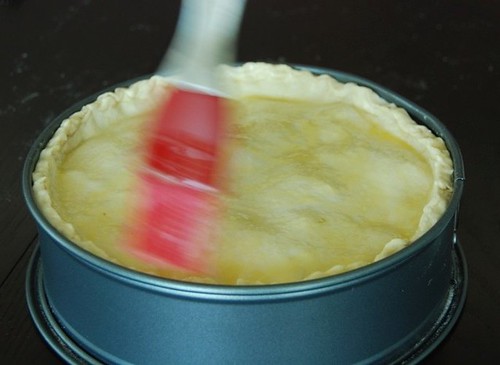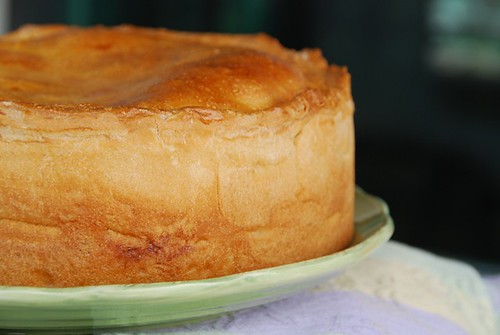
Next week, Italian women everywhere will be knee deep in eggs, butter, sugar, and ricotta cheese -- it's time for making Easter pies. Easter, as with most holidays for Italians, is a time for culinary celebration.
Both sweet and savory pies are a hallmark of an Italian Easter. Last year I shared the story of my grandmother's famous Italian Easter ricotta pie with pineapple that solidified her place as the best ricotta pie baker in the family. Then, last Sunday, I shared my personal favorite: sweet Easter rice pie. I'd feel remiss if I didn't share the granddaddy of all Easter pies: Pizza Chena.
Every year my grandmother made countless delicious Easter pies. And every year starting several weeks before Easter, anyone who even remotely knew her would start visiting or calling her. Their motive: to butter her up enough to get a piece of her Pizza Chena.
Nan, as my mother would say, "was dumb as a fox;" she knew when people were only after her Pizza Chena, and she wasn't going to give it to just anybody. That's because it was time-intensive and expensive to make. Of course, her mailman always got a piece because he would tell Nan that of all the Italian women in the neighborhood her Pizza Chena was the best. (Not too subtle, but it worked every time.)
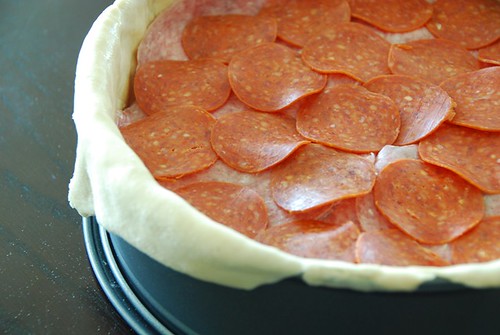
(layering the Pizza Chena)
Since Nan moved into an Alzheimer's unit several years ago, we haven't had Pizza Chena. It's one of a few dishes that my mom lost the desire to make after Nan wasn't able to cook anymore. So my mom was both delighted and nostalgic when I called her for the recipe.
Pizza Chena, a Neapolitan dialect term meaning “full pie,” is a colossal two-crusted savory pie stuffed with various Italian meats, cheeses, and eggs. All of that savory “fullness” is encased in either a flaky pastry crust or, as my family made, a satisfyingly chewy pizza dough crust.
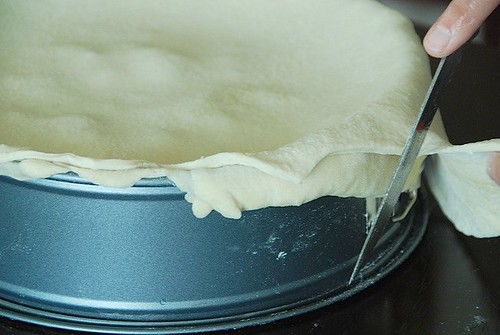
(trimming the dough)
Pizza chena, is often mispronounced by Italian-Americans (including my family) as “Pizza Gaina.” We always joked that when you eat it you "gain-a" a lot of weight.
There are many regional differences in making Pizza Chena; my grandmother made hers with hot sausage, fresh basket cheese, mozzarella, and hard boiled eggs, preferences passed down from her Campanian mother-in-law. Thank goodness her mother-in-law, known as "Big Nana," liked my grandmother so much. If she didn't, then my family might never have enjoyed so many of these scrumptious Easter dishes.
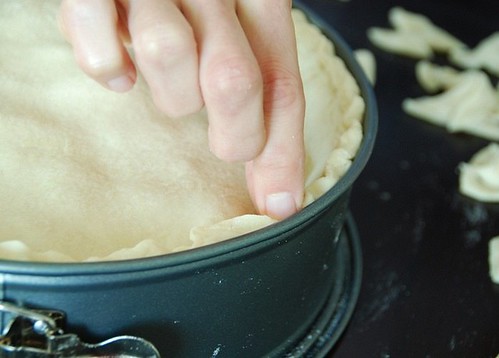
(pinching the dough)
When Jeff called my dad to tell him how delicious my Pizza Chena was last week, he asked if we had eaten it all. "All of it? Dad, there's enough 'Pizza Gaina' for 12 people!" Jeff said.
My dad replied, "You know, 'Pizza Gaina' freezes really well. You could just slice the rest of the pie and freeze the individual pieces. Then you could take out a couple when company comes." (Not too subtle, but it works every time.)
I wanted to surprise him, but what the heck. Don't worry, Dad, there are a couple of thick wedges of Pizza Chena in the freezer with your name on them.
(adding the egg wash)
I'm sending this special recipe to a special blogger friend, Alanna of A Veggie Venture, who is hosting Pi Day, in honor of pi, the mathematical constant of 3.14 and a trillion more digits. Just the thought of pi brings back nightmares of high school geometry, but I persevered because I couldn't pass up sharing this amazing recipe with you.
I just realized that my friend Chris from Melecotte is guest hosting this month's Apple and Thyme event (created by the ladies of Vanielje Kitchen and The Passionate Palate), so I had to submit this story to her. Chris also writes lovingly about her family, so check out her blog if you're not familiar with it.
Here's how to make traditional Italian Pizza Chena (for Easter or any time of the year):
Italian Pizza Chena
Serves 10-14
Print recipe only here.
Dough:
Makes approximately 2 pounds.
1 tablespoon sugar
1 tablespoon salt
2 cups of warm water
5-6 cups all-purpose flour
2 tablespoons olive oil
Filling:
1 teaspoon olive oil
1/2 pound fresh, hot Italian sausage (in casing)
1/2 pound capocollo, thinly sliced
1/3 pound Genoa salami, thinly sliced
1/3 pound pepperoni, thinly sliced
1 pound fresh basket cheese***
1/2 pound mozzarella cheese, thinly sliced
1 dozen eggs (8 will be beaten, 4 will be hard boiled)
1/3 cup minced fresh flat leaf parsley
15-20 cranks freshly ground black pepper
1 egg beaten with 1 teaspoon water for egg wash
Place the dough ball in a large, clean bowl coated with olive oil and rub some olive oil on top of the dough. Cover with a clean, dry dishtowel and let rise in a warm, draft-free area until doubled in size (at least 2 hours). (For more tips on making fail-proof pizza dough, click here.)
Meanwhile, fill a large, heavy-bottom saucepan halfway with water. Bring to a light, rolling boil, and place four room temperature eggs in the water. Maintaining a light, rolling boil, cook them for 18-20 minutes. Using a slotted spoon, remove the eggs, place in a colander, and run under cool water. Tap the eggs against the counter top to crack the shells; remove the shells, and rinse the boiled eggs under cool water. Slice thinly and set aside.
Meanwhile, heat 1 teaspoon olive oil in a large skillet over medium heat. Remove the sausage from its casing and add to the pan. Cook for 5-6 minutes, or until browned and crispy. Transfer to a small bowl and set aside.
Place oven rack in center of oven and preheat to 350 degrees F. Brush the inside surface of a 10 X 3 spring form pan with olive oil.
 Once the dough is risen, punch it down to release air bubbles. Transfer dough to a lightly floured surface, divide in half, and roll one half into a 12-inch round. Transfer the dough to a 10-inch spring form pan. Using your hands, fit the dough snugly in the pan, gently stretching it to hang 1 inch over the edge of the pan.
Once the dough is risen, punch it down to release air bubbles. Transfer dough to a lightly floured surface, divide in half, and roll one half into a 12-inch round. Transfer the dough to a 10-inch spring form pan. Using your hands, fit the dough snugly in the pan, gently stretching it to hang 1 inch over the edge of the pan.In a medium bowl, whisk together the 8 eggs, parsley, and black pepper.
 Fill the inside of the dough with alternating layers of sliced meats, cheeses, and sliced hard-boiled eggs. After 5-6 layers, pour half of the egg mixture over the filling allowing it to seep down. Continue layering the meats and cheeses, then pour the remainder of the the egg mixture evenly over the top. You should have enough for 10-12 layers.
Fill the inside of the dough with alternating layers of sliced meats, cheeses, and sliced hard-boiled eggs. After 5-6 layers, pour half of the egg mixture over the filling allowing it to seep down. Continue layering the meats and cheeses, then pour the remainder of the the egg mixture evenly over the top. You should have enough for 10-12 layers.On a lightly floured surface, roll out the second half of the dough to a 12-inch round. Place the dough over the filling, and using a sharp knife, trim excess dough until it just meets the rim of the pan.
 Using your fingertips, pinch the edges of the dough together, and gently roll the bottom layer over the top layer creating a seal. Then pinch the dough between your thumb and index finger creating a slightly fluted edge all around. Brush the top of pie with the egg wash.
Using your fingertips, pinch the edges of the dough together, and gently roll the bottom layer over the top layer creating a seal. Then pinch the dough between your thumb and index finger creating a slightly fluted edge all around. Brush the top of pie with the egg wash.Bake pie for 60- 75 minutes, or until the crust is golden brown. Remove from the oven and allow to cool at least 20-25 minutes. Release the spring and transfer the pie to a serving plate. Cut into wedges and enjoy at room temperature.
Leftover pizza chena can be stored in an air-tight container in the refrigerator for 5-7 days. Individual slices can also be wrapped tightly in tinfoil and placed in a heavy-duty freezer bag for up to two months.
***Fresh basket cheese is a semi-soft cheese that is used primarily for binding ingredients together. It can be found at Italian markets and cheese shops. If you can't find it, then substitute one (15-ounce) container of ricotta cheese (drained) and whisk it with 2 large eggs.
You might also like these savory Italian calzones, pizzas, and sandwiches:
- Spinach, Nutmeg, and Ricotta Pie
- Broccoli Rabe and Sausage Sandwich with Provolone
- Patriots' Potato Pizza
- Homemade Pizza with Fennel Sausage and Rapini (includes tips for making great homemade pizza dough)
 Save This Page on Del.icio.us
Save This Page on Del.icio.us